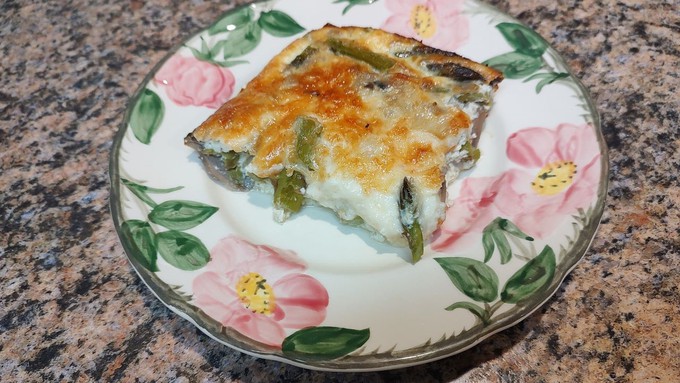
Recipe: Easy asparagus-mushroom bake with eggs and cheese

Light and creamy, asparagus-mushroom bake can be a meatless main course or side dish. Debbie Arrington
This easy, eggy casserole showcases one of my favorite vegetables of early spring – asparagus.
With a light and creamy egg base, this dish is perfect for brunch or as the main course in a meatless meal. It also works as a side dish for upcoming family celebrations such as Easter or Mother’s Day.
Precooking the asparagus with the mushrooms and onion eliminates most of the vegetable’s excess moisture. Otherwise, the casserole can come out soggy.
Asparagus-mushroom bake
Makes 4 to 6 servings
2 tablespoons olive oil
½ cup onion, chopped
2 cups white or cremini mushrooms, sliced
1 pound asparagus, cut into 1-inch pieces
¼ cup water
4 eggs
1 cup milk
¼ teaspoon hot sauce
1-1/2 cups jack cheese, grated
Preheat oven to 350 degrees F.
In a large skillet, heat oil. Saute onion over medium heat until translucent. Add mushrooms and continue sauteing until limp. Add asparagus and stir fry until pieces start to change color to bright green. Add water and cover pan. Turn heat down and let asparagus-mushroom mixture simmer until asparagus is tender, about 7 to 10 minutes depending on the thickness of the asparagus.
In a medium bowl, beat eggs until light. Add milk and mix to combine. Stir in hot sauce, then add the cheese.
Prepare an 8- by 8-inch baking dish; grease or spray with non-stick cooking spray.
Drain asparagus-mushroom mixture well, squeezing out as much moisture as possible. Transfer asparagus-mushroom mixture to prepared pan. Pour egg mixture over asparagus-mushroom mixture. Using a wooden spoon, gently swirl combined mixtures so asparagus is well distributed and all pieces are submerged in the egg mixture.
Place casserole on center rack in preheated oven. Bake casserole in 350-degree oven until top is golden and puffy, about 45 minutes.
Let cool slightly and serve.
Comments
0 comments have been posted.Sacramento Digs Gardening to your inbox.
Sites We Like
Garden Checklist for week of April 21
This week there’s plenty to keep gardeners busy. With no rain in the immediate forecast, remember to irrigate any new transplants.
* Weed, weed, weed! Get them before they flower and go to seed.
* April is the last chance to plant citrus trees such as dwarf orange, lemon and kumquat. These trees also look good in landscaping and provide fresh fruit in winter.
* Smell orange blossoms? Feed citrus trees with a low dose of balanced fertilizer (such as 10-10-10) during bloom to help set fruit. Keep an eye out for ants.
* Apply slow-release fertilizer to the lawn.
* Thoroughly clean debris from the bottom of outdoor ponds or fountains.
* Spring brings a flush of rapid growth, and that means your garden is really hungry. Feed shrubs and trees with a slow-release fertilizer. Or mulch with a 1-inch layer of compost.
* Azaleas and camellias looking a little yellow? If leaves are turning yellow between the veins, give them a boost with chelated iron.
* Trim dead flowers but not leaves from spring-flowering bulbs such as daffodils and tulips. Those leaves gather energy to create next year's flowers. Also, give the bulbs a fertilizer boost after bloom.
* Pinch chrysanthemums back to 12 inches for fall flowers. Cut old stems to the ground.
* Mulch around plants to conserve moisture and control weeds.
* From seed, plant beans, beets, cantaloupes, carrots, corn, cucumbers, melons, radishes and squash.
* Plant onion sets.
* In the flower garden, plant seeds for asters, cosmos, celosia, marigolds, salvia, sunflowers and zinnias.
* Transplant petunias, zinnias, geraniums and other summer bloomers.
* Plant perennials and dahlia tubers for summer bloom.
* Mid to late April is about the last chance to plant summer bulbs, such as gladiolus and tuberous begonias.
* Transplant lettuce seedlings. Choose varieties that mature quickly such as loose leaf.